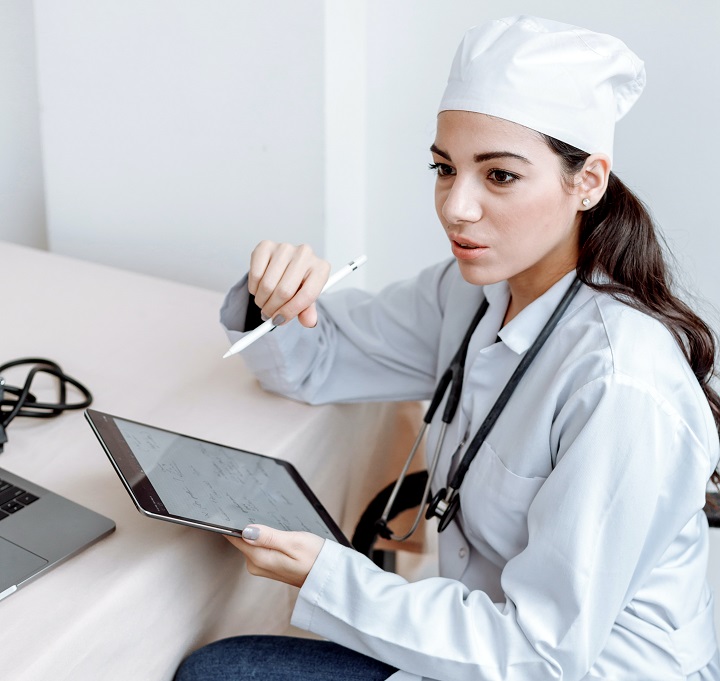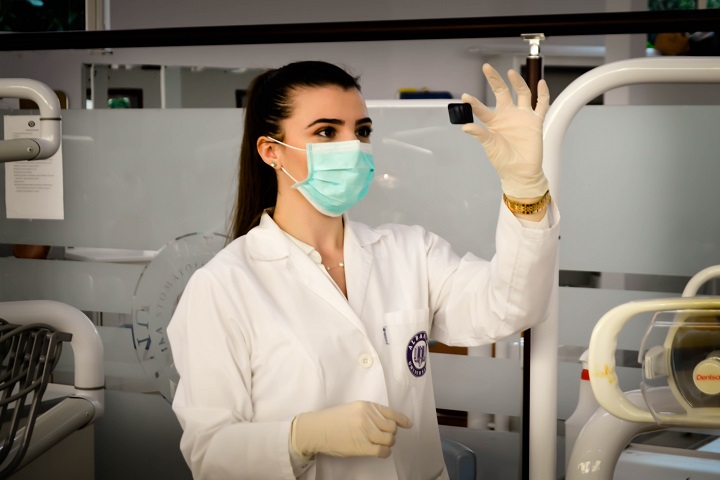If caught in time, even the most serious ailment has a chance of being cured. That fear of COVID doesn’t make you stay home. Find out when you SHOULD GO TO THE DOCTOR (no excuses!).
Aitana found a burrito in her chest in April last year. Despite the scare he took, confinement and fear of contagion caused him to stay home. He did not consult with the doctor then, in May or June. Well into July, he decided to go because the package was still there.
In his case, he confirmed the worst prognosis. It was breast cancer. Although today he is already in expert hands and his life is not in danger, his case would have been easier to deal with if he had gone earlier. And what worries the experts the most are all the Aitanas (and Antonios) who have not decided to go to the consultations.
1. The Problem Is That There Are Many More Aitanas
The combination of hospitals overwhelmed by the COVID-19 pandemic and people afraid to go to the doctor to get infected in the waiting room led to the perfect storm. Many serious ailments are not being diagnosed because people are staying home. And when they get into the hands of a doctor, they’re in more advanced stages, which makes them have a worse prognosis.
Without going any further, the Society of Medical Oncology (SEOM) has calculated that, throughout 2020, 1 in 5 cases of cancer in western countries has ceased to be detected, that is, 20% less than in previous years.
2. The Other “Wave” That Is Coming Upon Us After Covid
Doctors fear that once the pressure due to the coronavirus loosens, problems due to the delay in diagnosing other diseases will emerge, and there will be another “wave” of cases that will be, like Aitana’s, more difficult to treat. Taking cancer as an example, “with a lower rate of diagnosis, we are concerned about whether tumors will arrive at more advanced stages, or if they will arrive.”
Go to the doctor when necessary. Don’t do like Aitana. Don’t worry, take care of yourself. Go to the doctor if you detect a burrito, a mole that changes appearance, or a sore in the mouth that does not heal. So that you can guide yourself, we have developed this “anti-panic guide” with easy-to-do checks at home that will help you see if you should ask for a consultation.
3. How Is Your Heart?
Taking stress regularly at home and considering certain symptoms can give you an idea of whether your heart is at risk.
How should you do it? The ideal is to take it in the morning on an empty stomach. Sit down earlier to be relaxed. You must have your back supported, your legs unbroken, and your arm supported and at the height of the heart. If the values are equal to or greater than 14/9 cm/Hg, it is high, and if this happens often, it may be due to heart problems.

Have you got yellow bumps on your eyelids? It may indicate that blood cholesterol has skyrocketed. Check with your doctor because it is a major risk factor for heart disease.
Do you feel heartburn and palpitations? If you also have back or shoulder pain, cold sweat, pressure on the chest behind the sternum, or notes of pangs, nausea, or drowning, you could be suffering a heart attack because they are the most frequent symptoms in women.
4. Do You Breathe Well? Are You Aphonic?
Knowing the state of our lungs is important not only because of COVID-19 but also because doctors warn that lung cancer continues to rise in women due to smoking and chronic obstructive pulmonary disease (COPD).
How do we evaluate it then? Holding your breath, ideally underwater (from the bathtub?). In principle, if you manage to have more than half a minute, your lungs are in good health.
Are you aphonic and haven’t let your voice sing? If there is no reason to do so, aphonia lasting more than two weeks deserves a consultation because it could be a symptom of laryngeal cancer.
What is your blood oxygen level like? If the oxygen level is low, you should consult with your doctor, as it can be related to diseases of the respiratory system and heart problems. Two things can tell you. One is that the nails look blue or purple without being caused by a bruise. Another is that the fingers have adopted a drumstick shape for playing the drum (thicker at the tip).
5. Do You Check Your Chest Regularly?
Like Aitana, 1 in 8 women will have breast cancer. The sooner it is detected, the better, so once a month –the better after the period–, exploit your breasts. Look at this:
- Soft and moves. It is usually a lump of fat. It differs from a malignant tumor because it is hard and is anchored in the skin.
- Sealed bag. You notice it under the skin, and its growth is usually slow, although not always, sometimes it is faster. It is generally due to a cyst but can be confused with a tumor, so better to consult.
- Hard and rounded. It is also better to consult because it is usually a fibroadenoma and is common in women with very fibrous breasts; it can be confused with a malignant tumor. Various and irregular. If your breasts are fibrous, what you may notice are their glands and ducts.
Has it been inflamed for a long time? It is normal for the chest to be somewhat inflamed before the period, but consult if this sensation lasts all month. It may be the earliest symptom of a rare but very aggressive type of cancer. It may be accompanied by redness, itching, burning, or pain when palpating.
6. Do You Have a Swollen and Relaxed Belly?
Ovarian cancer is the sixth most common cancer in women. It is a silent disease, hard to detect even doing an annual gynecological check-up because it does not give symptoms till it is very advanced, nor are there specific diagnostic tests for other gynecological cancers (mammography in the case of the breast or cytology in the case of the cervix). But there is a feeling that can alert you, which is abdominal swelling. It can be due to many reasons, but I suspect there is détente as well.
How do I know? The swelling is more of a feeling of being full, heavy, But bloating, with a tape measure. It is an objective fact that the perimeter of your abdomen increases. If, in addition, you have a constant need to go to the bathroom or you are full after eating, consult with the gynecologist.

7. Before Pulling the Chain, Look at This…
We should check our bowel movements with some frequency because they can give us many clues about our health, particularly colon cancer, the second most common tumor in women and men. He thinks that 90% of cases could be cured if detected in the early stages.
Why check stool? Because a change in your evacuation habits – alternating constipation with diarrhea – or in the shape or size of your stool over a certain period can be signs of colon cancer.
What should alert me? Your bowel movements have a thin shape like that of a pencil, which could be due to the presence of polyps, normally benign lumps, but that can be a malignancy. Also, they have a blackish color or black parts because it indicates that there may be blood in the stool due to these polyps.
8. And Also Look at the Color of Your Urine…
And the color of your urine gives you many clues also of the health of your kidneys or liver. It may not be life or death, yet it is a reason to consult with the doctor.
What to look for? If you haven’t taken foods that can stain urine, such as beets or dyes, etc., and it’s reddish or dark brown, ask for time with your doctor. This symptom can be accompanied by others, such as yellowing eyes, and tiredness.
9. Apply the “ABCD” Rule to Your Skin
The incidence of skin cancer is increasing. Every year, 10% more cases of basal cell carcinoma, one of its most common forms, are diagnosed. Therefore, regularly checking our freckles and moles and applying the “ABC” rule is a guide to detecting possible skin tumors.
What does each letter correspond to?
- Asymmetric. That the mole is asymmetrical is the first warning sign.
- Borders. Skin cancer has jagged or poorly defined edges.
- Color. Be suspicious when the color of the mole changes from one area to another. It can go from bronze to black, or it can be white, red, or blue.
- Diameter. Rapid growth is also often a bad symptom.
Don’t leave yourself anywhere. Start with the head, follow the trunk, and back. In this region, if you do not have the help of another person, you can check it using two mirrors. It ends with arms and legs. You also need to fit behind the ears and scalp. You can ask your hairdresser.
10. Checkups, Why Are They Important?
Because the early detection of serious diseases is key to overcoming them.
- Stroke. 30% of strokes leave disabling sequelae due to going late to the emergency room. If it arrives 4 hours after occurring, it may not leave sequelae, but after 8h the brain damage can be irreversible.
- Breast cancer. The chances of curing breast cancers that are detected in their initial stage are almost 100%.
- Colon cancer. 90% of cases could be cured if detected in the early stages.
- Lung cancer. 92% of lung cancer is cured if it is detected early.
- Infarction. A study has shown that calling 112 instead of going to the emergency room by your means improves survival and can avoid complications.
11. Three Stroke Symptoms You Should Know
- Smile. Suspect if, when trying to smile, the right or left side of the mouth does not move. There may be tingling on that side of the body.
- Repetition. When the stroke occurs, the affected person may have trouble even repeating very simple phrases. Ask you to do so to check it out.
- Arms Up. Another very clear symptom is that when you ask yourself to raise your arms, it is impossible for you or fall in doing so.
- And Also. You may also feel a sudden headache, impaired vision (see blurry, double) or suffer from unbalanced or dizziness.

